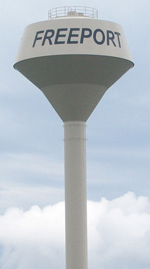Constructing and upgrading wastewater treatment facilities have been a Recovery priority for both the U.S. Department of Agriculture and the Environmental Protection Agency. USDA’s Rural Utilities Service (RUS) allotted $1.3 billion in Recovery funds for water and wastewater facilities, EPA $3.9 billion.
Below are five projects that have been funded.
Johnson County, Kansas
 Artist's rendition of the interior of the new fats, oils, and greases processor at the Douglas L. Smith Middle Basin Treatment Plant. (Photos provided by Johnson County Wastewater, Olathe, KS)
Artist's rendition of the interior of the new fats, oils, and greases processor at the Douglas L. Smith Middle Basin Treatment Plant. (Photos provided by Johnson County Wastewater, Olathe, KS)According to EPA, which provided an $18.4 million Recovery loan, improvements made to Johnson County’s Douglas L. Smith Middle Basin Treatment Plant constituted “the largest green infrastructure project” in the state. Improvements included a processing system for capturing biogases from waste, and a separate system to more efficiently receive and treat used greases and oils from restaurants and industries.
Officials expect the project will yield almost $600,000 in annual savings for Johnson County customers and will also reduce annual greenhouse gas emissions by more than 9,700 metric tons. A ribbon-cutting ceremony for the new facilities was held in October 2011.
Freeport, Minnesota
 New water tower for Freeport, MN. (Photo courtesy Brett Repulske, USDA Rural Development)
New water tower for Freeport, MN. (Photo courtesy Brett Repulske, USDA Rural Development)RUS awarded a $1.35 million loan to replace an aging water tower with a larger one and upgrade the water mains and sewer lines in this town of 450 residents. All work was recently completed, and expected public benefits include increased water pressure, higher water quality, and improved treatment of wastewater. Officials say public safety is also improved through increased water pressure at fire hydrants.
Wolfe County, Kentucky
With the help of an $892,000 Recovery grant and a matching $892,000 Recovery loan – both from USDA – Wolfe County officials were able to build a water treatment plant in this Appalachian region of Kentucky. The new plant was needed to meet water quality regulations and provide improved water service to about 7,300 people living in the area. The old water system had outgrown its current capacity. The plant opened in May 2012.
Upper St. Croix Watershed, Wisconsin
 Two new treatment ponds in Solon Springs. (Photo courtesy of Kelly Edwards, USDA Rural Development)
Two new treatment ponds in Solon Springs. (Photo courtesy of Kelly Edwards, USDA Rural Development)Located in the northwest corner of Wisconsin, the Upper St. Croix watershed spans more than 177,000 acres and contains 153 miles of streams and rivers, plus abundant lakes, wetlands, and forests. Solon Springs, a town near the watershed, recently marked the opening of a new wastewater treatment facility, which was needed to serve the town’s 600 residents and protect the watershed from pollution. USDA awarded Solon Springs a $1.54 million Recovery loan and a $727,000 Recovery grant for improving overall water quality management. The U.S. Army Corps of Engineers provided an additional $1.1 million in Recovery funding.
Kewaunee, Wisconsin
The city of Kewaunee, east of Green Bay, marked the completion of renovations and upgrades to its wastewater treatment plant with a community celebration and ribbon cutting on June 9. The original treatment facility is over 50 years old, exceeding its design life by more than 30 years. The improvements were necessary to bring the facility in compliance with recent requirements set by the Wisconsin Department of Natural Resources, and to meet existing and future wastewater treatment needs of the community.
Improvements included the addition of process units and buildings. The project also included construction of a new laboratory/administration and headworks building that will include screening, grit removal equipment, flow metering, raw influent pumps, motor control equipment, and aeration blowers. USDA Rural Development funded the project with a combined Recovery loan and grant totaling $6.9 million.
Back to Featured Stories